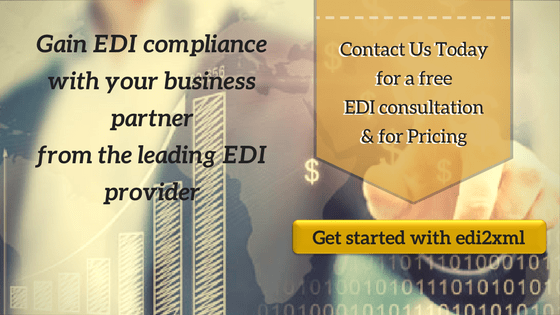UN / EDIFACT Standard Overview
What is UN/EDIFACT standard?
United Nations/Electronic Data Interchange for Administration, Commerce and Transport (UN/EDIFACT) is the International EDI standard ISO 9735-1987, developed under the UN
The general standard is adopted by national and sectoral standards bodies to better reflect the needs of each industry.
At least twice a year, the standard is updated globally. The reason of this update is to create a new directory of data and messages, in addition to improving the usability of existing EDIFACT messages.
The UN/EDIFACT standard has been developed for trade and transport management. The concept of “trade” was interpreted in a broad sense (orders, deliveries, insurance, payment of goods, customs formalities). Currently, the use of UN/EDIFACT has expanded to include accounting, customs control, pensions, health care, social insurance, judicial practice, employment, statistics, construction, finance, insurance, manufacturing, tourism, trade, freight, and container transportation.
The UN/EDIFACT standard is developed and supported by two international organizations: United Nations Economic Commission for Europe — UN ECE and the International Organization for Standardization. – ISO
EDIFACT Subsets
EDIFACT is predominant outside of North America. Due to its complexity, branch-specific subsets of EDIFACT have been developed. These subsets are subsets of EDIFACT and contain only the functions relevant to specific user groups, such as:
- EANCOM consumer goods industry
- ODETTE European automotive industry.
- CEFIC chemical industry
- EDICON standard used in the construction industry
- RINET – the Insurance industry
- HL7 standard is used in healthcare.
- IATA air transportation
- SWIFT banking
- UIC 912 rail transport
- EDIFICE electronics, software, and telecommunications industry. EDIFICE has played an important role in the implementation of RosettaNet standards in Europe. EDIFICE became the European RosettaNet User Group.
EDIFACT Messages: Structure and Syntax of the Standard
EDIFACT is a special, structured data language that describes all types of commercial activities, based on information logistics. Using elements and segments of standard informational messages, you can create a description of any document, generate its electronic form and transmit it in open telecommunication networks without fear of interception of private commercial information.
UN / EDIFACT Structure
Any document in UN / EDIFACT standard has a hierarchical structure. The entire electronic document is called a message. A message consists of data groups combined in some way, for example, a data group describing customs payments, a group of data describing the attributes of documents, etc. In turn, the group consists of typical data segments that describe document attributes in more details. The standard provides about 200 different types of segments from which messages are composed. The segments themselves also have a hierarchical structure and consist of data elements that can be simple (data field) and composite (usually 2-3 data fields).
The following is the structure of an EDIFACT transmission:
- Service String Advice
- Interchange Header
- Functional Group Header
- Message Header
- User Data Segments
- Message Trailer
- Functional Group Trailer
- Interchange Trailer
Example EDIFACT
UNA:+.? ‘
UNB+UNOB:2+ XYZCORPORATION:ZZ+COMPANYX:ZZ+190521:1604+906019++++++1′
UNH+1+ORDERS:D:96A:UN’
BGM+220+4500265532+9′
DTM+137:20190425:102′
RFF+CT:CompanyX’
NAD+BY+2010::91′
CTA+OC+2010:G. Smith ‘
COM+044-1010605:TE’
COM+044-1010662:FX’
NAD+SE+0000906300::92′
CTA+SC+0000906300′
NAD+DP+++Consulting Inc St+ Begun + Laval++8003+CA’
CUX+2:CHF:9′
LIN+10++TH300010:BP’
PIA+1+000000000000500807:SA’
IMD+A++::92:HIR0010H12′
QTY+22:1:PCE’
DTM+2:20190423:102′
LIN+20++T0004671:BP’
PIA+1+000000000000501516:SA’
IMD+A++::92:CCGT060204NS LT1110S’
QTY+22:10:PCE’
DTM+2:20190423:102′
LIN+30++T2001171:BP’
PIA+1+000000000000501328:SA’
IMD+A++::92:LTPNG-R20-3.0′
QTY+22:1:PCE’
DTM+2:20190423:102′
UNS+S’
UNT+28+1′
UNZ+1+906019′
Principles and Technologies of Application of the UN / EDIFACT Standard
The EDIFACT Standard has three types of reference books:
The first type is directories that are based on the ISO standards. It includes directories of currency codes, country codes, units of measurement, modes of transport, delivery conditions, and some others.
The second type of directories, are the ones included in the EDIFACT standard., by default
The third type of directories is developed by different organizations responsible for issuing codes. Here is the list of organizations 3055 Code list responsible agency code
There are four main components in EDIFACT that are subject to standardization, when preparing documents for exchange between business partners.
- data elements
- standard data segments
- standard messages
- syntax rules
Data elements are the smallest, non-dividing parts of information, for example, the document date, the name of the destination, the amount of tax. More than 600 data elements used in international trade and transport have been published in a special UNTDID directory.
EDIFACT Standard Principles
The UN / EDIFACT standard is based on the following principal:
1. Standardize data at the segment and element level. Any document intended for electronic exchange should consist of typical segments. This means that the segment of the supplier’s address or delivery address is described by the same elements, regardless of what kind of document it is – invoice, order, declaration, etc. The practice has shown that to describe almost any document, it is enough to have no more than 100 typical segments. The fields inside the segments are standardized the same way, and the ratio of fields to segments is one-to-many, i.e. the same field can be included in different segments.
2. Record the fields used in segments as code. It is assumed that the partners exchanging electronic documents have identical code tables (directories). The composition and content of the reference books is standardized at three levels – international, national and corporate.
3. The independence of standards from the language of communication. The peculiarity of the UN / EDIFACT standards is that more than 90% of the electronic message consists of different codes. Another feature is that only the content of the document is transmitted, without a form. The document form is restored when the message is decoded.
Book a FREE one-on-one EDIFACT consultation session with our in-house experts.
EDIFACT Messages
The EDIFACT standard which provides a set of standard messages has greatly simplified international and multi-branch trade and the exchange of electronic business documents between countries and various industries.
The standard message UN / EDIFACT has a six-letter identifier that reflects the short name of the message, for example:
- CUSDEC – CUStoms DEClaration
- CUSRES –CUStoms RESponse
Some of the standard EDIFACT messages with X12 equivalent are listed in the table below.
| X12 Transaction Number | EDIFACT Transaction ID | Transaction name |
| 850 | ORDERS | Purchase order message |
| 855 | ORDRSP | Purchase Order Acknowledgment |
| 846 | INVRPT | Inventory Inquiry/Advice |
| 856 | DESADV | Shipment Notification ASN |
| 810 | INVOIC | Invoice |
| 997 | CONTRL | Functional acknowledgment |
| 860 | ORDCHG | Purchase Order Change – Buyer Initiated |
Due to the independence from the language and the transfer of only the contents of the document, the restoration of the form of the document takes place on the receiving side in accordance with the rules that apply in this place.
Benefits of EDIFACT

EDIFACT has a competitive advantage that positively affects the efficiency of a company and improves business processes. The main advantages of EDIFACT:
Profitability – reducing the volume of papers to be processed leads to a decrease in personnel and administrative costs.
Efficiency – large volumes of commercial data can be transferred from one computer to another within minutes
Accuracy – the use of EDIFACT eliminates human errors that are inevitable when manually keying in data.
EDIFACT is a key component of a just-in-time strategy that ensures prompt customer satisfaction. EDIFACT in conjunction with the Internet allows real-time electronic transactions and accelerates the interaction between trading partners.
Easy EDIFACT Integration
Our company has many years of proven experience in implementing EDI and EDIFACT projects. We offer our clients Fully managed EDI Service and HTTP Web Service.
Contact us today for a free consultation and we will help you find the best option for your business.




 RosettaNet is a non-profit organization having more than 500 high-tech companies as members. These members create and implement open standards for processing business to business (B2B) transactions, especially at the supply chain level, in their appropriate vertical. The main mission of RosettaNet organization is to generate standard protocols for specific business transactions such as new Product Information, order Management, design registration, request technical data, etc.
RosettaNet is a non-profit organization having more than 500 high-tech companies as members. These members create and implement open standards for processing business to business (B2B) transactions, especially at the supply chain level, in their appropriate vertical. The main mission of RosettaNet organization is to generate standard protocols for specific business transactions such as new Product Information, order Management, design registration, request technical data, etc. RosettaNet optimizes existing standards, guidelines, and specifications of open e-business for cross-platform applications and network communications. RosettaNet defines the concepts of e-business (file formats, procedures, implementation, requirements, etc.) and develops standards for ensuring compatibility of business processes. RosettaNet is based on open XML standards.
RosettaNet optimizes existing standards, guidelines, and specifications of open e-business for cross-platform applications and network communications. RosettaNet defines the concepts of e-business (file formats, procedures, implementation, requirements, etc.) and develops standards for ensuring compatibility of business processes. RosettaNet is based on open XML standards.
